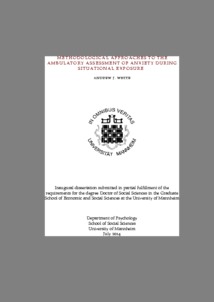|
Methodological approaches to the ambulatory assessment of anxiety during situational exposure
White, Andrew J.
![[img]](https://madoc.bib.uni-mannheim.de/style/images/fileicons/application_pdf.png)  Vorschau |
|
PDF
AJW_dissertation.pdf
- Veröffentlichte Version
Download (7MB)
|
|
URL:
|
https://madoc.bib.uni-mannheim.de/37279
|
|
URN:
|
urn:nbn:de:bsz:180-madoc-372798
|
|
Dokumenttyp:
|
Dissertation
|
|
Erscheinungsjahr:
|
2014
|
|
Ort der Veröffentlichung:
|
Mannheim
|
|
Hochschule:
|
Universität Mannheim
|
|
Gutachter:
|
Alpers, Georg W.
|
|
Datum der mündl. Prüfung:
|
22 Oktober 2014
|
|
Sprache der Veröffentlichung:
|
Englisch
|
|
Einrichtung:
|
Außerfakultäre Einrichtungen > GESS - CDSS (SOWI)
Fakultät für Sozialwissenschaften > Klinische u. Biologische Psychologie u. Psychotherapie (Alpers 2010-)
|
|
Fachgebiet:
|
150 Psychologie
|
|
Normierte Schlagwörter (SWD):
|
Psychologie , Angststörung , Verhaltenstherapie , Psychotherapie , Physiologische Psychologie
|
|
Freie Schlagwörter (Englisch):
|
Ambulatory assessment , anxiety , panic disorder with agoraphobia , situational exposure , psychophysiology , GPS , heart rate
|
|
Abstract:
|
Developing more nuanced understandings of psychological processes involved in mental disorders helps to further improve empirically supported treatments. Exposure-based therapy is a frequently employed, evidence-based treatment for anxiety disorders. Further refinement, however, may help to strengthen treatment response and prevent relapse. The overarching aim addressed in this dissertation is how assessing anxiety symptoms in the field can clarify who responds to exposure therapy. To this end, self-reported anxiety, physiological activation (heart rate), and location derived from global positioning system (GPS) coordinates, were collected from panic disorder with agoraphobia patients during repeated situational exposures.
In Study 1, a single case-study design, a novel approach to assess how a patient undertook situational exposure was outlined. Heart rate and GPS-derived position were collected to objectively document movement paths and accompanying physiological arousal during driving exposure. These measures helped reveal the extent of therapeutic compliance, inform the design of subsequent, suitably-challenging exposure tasks, and to track progress. The three remaining studies were based on data collected from the PanikNetz project, a multicentre clinical treatment trial. Treatment consisted of 12 sessions with a psychotherapist, during which time patients completed several standardised bus exposures. Study 2 examined the extent to which intrinsic and extrinsic factors shaped physiological responses during exposure, and whether different response types were apparent across individuals. This, in turn, helped determine whether disorder subtypes exist. This informed Study 3, in which the role of fear habituation during exposure was investigated using adherence to end-of-exposure instructions, in addition to central predictions from emotional processing theory. Finally, in Study 4, the effect of multiple exposure contexts (derived from GPS data) and compound stimuli (based on two exposure variants) were related to maintenance of treatment gains following treatment.
These studies underscored the value of exploring psychophysiological responses that manifest during situational exposure. When combined with laboratory findings, ambulatory assessment of anxiety can greatly help to identify factors that influence the success of exposure therapy.
|
 | Dieser Eintrag ist Teil der Universitätsbibliographie. |
 | Das Dokument wird vom Publikationsserver der Universitätsbibliothek Mannheim bereitgestellt. |
 Suche Autoren in Suche Autoren in
Sie haben einen Fehler gefunden? Teilen Sie uns Ihren Korrekturwunsch bitte hier mit: E-Mail
Actions (login required)
 |
Eintrag anzeigen |
|
|
